-
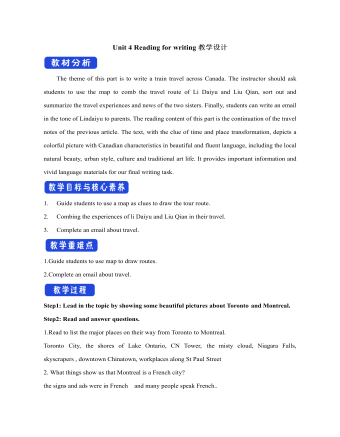
新人教版高中英语选修2Unit 4 Reading for writing教学设计
假定你是英国的Jack,打算来中国旅行,请你给你的中国笔友李华写一封信,要点如下:1.你的旅行计划:北京→泰山→杭州;2.征求建议并询问他是否愿意充当你的导游。注意:1.词数80左右(开头和结尾已给出,不计入总词数);2.可以适当增加细节,以使行文连贯。参考词汇:故宫 the Forbidden City;泰山 Mount TaiDear Li Hua,I'm glad to tell you that 'm going to visit China.First,I am planning to visit Beijing,the capitalof China,where I am looking forward to enjoying the Great Wall,the Forbidden City and somebeautiful parks.Then I intend to go to visit Mount Tai in Shandong Province.I've heard that it is one ofthe most famous mountains in China and I can't wait to enjoy the amazing sunrise there.After that,I amalso going to Hangzhou.It is said that it is a beautiful modern city with breathtaking natural sights,among which the West Lake is a well- known tourist attraction.What do you think of my travel plan? Will you act as my guide? Hope to hear from you soon.

新人教版高中英语选修2Unit 4 Using langauge-Listening教学设计
The theme of the listening section is " talking about scenery and culture along a journey."The part is designed to further lead the students to understand Canadian natural geography and social environment, and integrated into the cultural contrast by mentioning the long train journey from Beijing to Moscow routes. On this basis, the part activates students related travel experience, lets the student serial dialogue, guides the student to explore further the pleasure and meaning of the long journey, and Chinese and foreign cultural comparison.The part also provides a framework for the continuation of the dialogue, which is designed to provide a framework for students to successfully complete their oral expressions, and to incorporate an important trading strategy to end the dialogue naturally.1. Help students to understand and master some common English idioms in the context, and experience the expression effect of English idioms.2. Guide the students to understand the identity of different people in the listening context, and finish the dialogue according to their own experience.3. Instruct the students to use appropriate language to express surprise and curiosity about space and place in the dialogue, and master the oral strategy of ending the dialogue naturally.1. Instruct students to grasp the key information and important details of the dialogue.2. Instruct students to conduct a similar talk on the relevant topic.

新人教版高中英语选修2Unit 5 Learning about Language教学设计
The purpose of this section of vocabulary exercises is to consolidate the key words in the first part of the reading text, let the students write the words according to the English definition, and focus on the detection of the meaning and spelling of the new words. The teaching design includes use English definition to explain words, which is conducive to improving students' interest in vocabulary learning, cultivating their sense of English language and thinking in English, and making students willing to use this method to better grasp the meaning of words, expand their vocabulary, and improve their ability of vocabulary application. Besides, the design offers more context including sentences and short passage for students to practice words flexibly.1. Guide students to understand and consolidate the meaning and usage of the vocabulary in the context, 2. Guide the students to use the unit topic vocabulary in a richer context3. Let the students sort out and accumulate the accumulated vocabulary, establishes the semantic connection between the vocabulary,4. Enable students to understand and master the vocabulary more effectivelyGuiding the Ss to use unit topic words and the sentence patterns in a richer context.Step1: Read the passage about chemical burns and fill in the blanks with the correct forms of the words in the box.
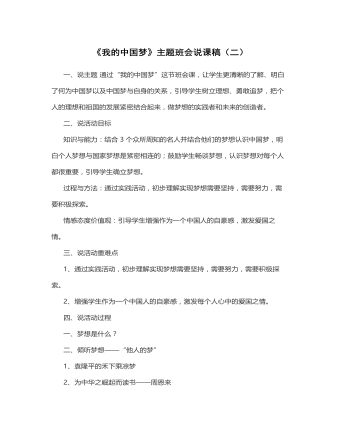
《我的中国梦》说课稿(2)
“我们的人民热爱生活,期盼有更好的教育、更稳定的工作、更满意的收入、更可靠的社会保障、更高水平的医疗卫生服务、更舒适的居住条件、更优美的环境,期盼着孩子们能成长得更好、工作得更好、生活得更好。人民对美好生活的向往,就是我们的奋斗目标。”四、中国梦这是一个绽放梦想的时代,每个人都是梦想家。中国梦从我的梦开始。同学们,在每一个阶段尽情放飞你的梦想,让他带领你前行,照亮你的人生。坚持梦想的过程,是一个不断超越自我、实现自我的过程。抬头看着你的梦想,脚踏实地的努力每天都离梦想更近一步。中国梦,承载着中国民主、富强、公正、和谐、自由的最基本价值观、承载着自强不息的中国精神。中国梦需要我们每一个人付出自己的努力,共筑梦想,让梦想照耀中国,善良世界。

北师大版初中八年级数学上册二元一次方程(组)与一次函数说课稿
在第1环节基础上,再让同学认识到函数Y=2X-1的图象与方程2X-Y=1的对应关系,从而把两个方程组成方程组,让学生在理解二元一次方程与函数对应的基础上认识到方程组的解与交点坐标的对应关系,从而引出二元一次方程组的图象解法。3、例题训练,知识系统化通过书上的例1,用作图象的方法解方程组,让学生明白解题步骤与格式,从而规范理顺所学的图象法解方程组,例题由师生合作完成,由学生说老师写的方式。4、操作演练、形成技能让学生独立完成书P208随堂练习,给定时间,等多数学生完成后,实物投影其完成情况,并作出分析与评价。5、变式训练,延伸扩展通过让学生做收上P208的试一试,而后给一定时间相互交流,并请代表发言他的所悟,然而老师归纳总结,并让学生通过自已尝试与老师的点拔从“数”与“形”两个方面初步体会某些方程组的无解性,进一步发展学生数形结合的意识和能力。6、检测评价,课题作业
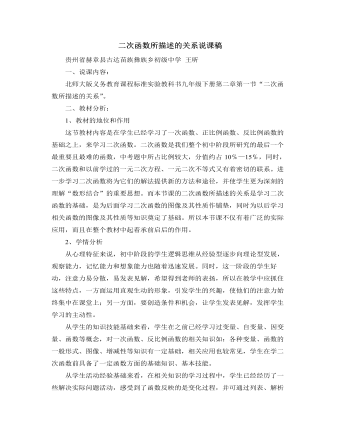
北师大版初中数学九年级下册二次函数所描述的关系说课稿
1、圆的半径是 ,假设半径增加 时,圆的面积增加 。(1)写出 与 之间的关系表达式;(2)当圆的半径分别增加 , , 时,圆的面积增加多少。【设计意图】此题由具体数据逐步过渡到用字母表示关系式,让学生经历由具体到抽象的过程,从而降低学生学习的难度。2、篱笆墙长 ,靠墙围成一个矩形花坛,写出花坛面积 与长 之间的函数关系式,并指出自变量的取值范围。【设计意图】此题稍微复杂些,旨在让学生能够开动脑筋,积极思考,让学生能够“跳一跳,够得到”。(六) 小结思考本节课你有哪些收获?还有什么不清楚的地方?【设计意图】让学生来谈本节课的收获,培养学生自我检查、自我小结的良好习惯,将知识进行整理并系统化。而且由此可了解到学生还有哪些不清楚的地方,以便在今后的教学中补充。(七)布置作业,提高升华必做题:课本P39-40随堂练习第1题,习题2.1第1题;
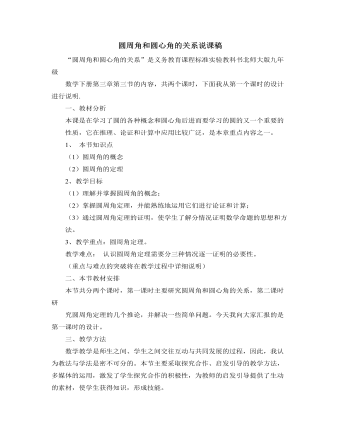
北师大版初中数学九年级下册圆周角和圆心角的关系说课稿
(设计意图:因为圆中有关的点、线、角及其他图形位置关系的复杂,学生往往因对已知条件的分析不够全面,忽视某个条件,某种特殊情况,导致漏解。采用小组讨论交流的方式进行要及时进行小组评价。)(3) 议一议( 如图,OA、OB、OC都是圆O的半径∠AOB=2∠BOC, 求证:∠ACB=2∠BAC。)(设计意图:通过练习,使学生能灵活运用圆周角定理进行几何题的证明,规范步骤,提高利用定理解决问题的能力。)(三)说小结首先,通过学生小组交流,谈一谈你有什么收获。(提示学生从三方面入手:1、学到了知识;2、掌握了哪些数学方法;3、体会到了哪些数学思想。)然后,教师引导小组间评价。使学生对本节内容有一个更系统、深刻的认识,实现从感性认识到理性认识的飞跃。(四)、板书设计为了集中浓缩和概括本课的教学内容,使教学重点醒目、突出、合理有序,以便学生对本课知识点有了完整清晰的印象。我只选择了本节课的两个知识点作为板书。
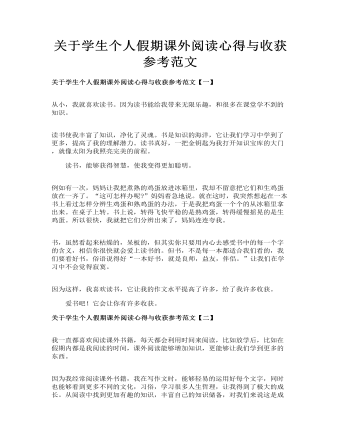
关于学生个人假期课外阅读心得与收获参考范文
我一直都喜欢阅读课外书籍,每天都会利用时间来阅读,比如放学后,比如在假期内都是我阅读的时间,课外阅读能够增加知识,更能够让我们学到更多的东西。 因为我经常阅读课外书籍,我在写作文时,能够轻易的运用好每个文字,同时也能够看到更多不同的文化,习俗,学习很多人生哲理,让我得到了极大的成长。从阅读中找到更加有趣的知识,丰富自己的知识储备,对我们来说这是成长,更是一次体验,课外阅读的好处不光是这些,更能够提升我们的阅读理解能力。
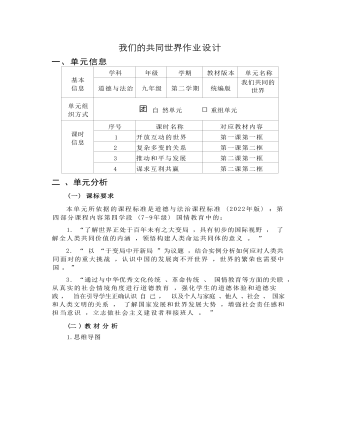
九年级下册道德与法治我们共同的世界2作业设计
(一) 课标要求本单元所依据的课程标准是道德与法治课程标准 (2022年版) :第 四部分课程内容第四学段 (7-9年级) 国情教育中的:1. “了解世界正处于百年未有之大变局 ,具有初步的国际视野 , 了 解全人类共同价值的内涵 ,领悟构建人类命运共同体的意义 。 ”2. “ 以 “于变局中开新局 ”为议题 ,结合实例分析如何应对人类共 同面对的重大挑战 ,认识中国的发展离不开世界 ,世界的繁荣也需要中 国 。 ”3. “通过与中华优秀文化传统 、革命传统 、 国情教育等方面的关联 ,从真实的社会情境角度进行道德教育 ,强化学生的道德体验和道德实 践 , 旨在引导学生正确认识 自 己 , 以及个人与家庭 、他人 、社会 、 国家 和人类文明的关系 , 了解国家发展和世界发展大势 ,增强社会责任感和 担当意识 ,立志做社会主义建设者和接班人 。 ”
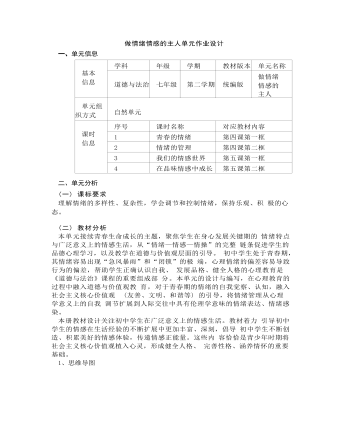
道德与法治七年级下册做情绪情感的主人作业设计
10.阅读材料,回答问题。材料一:近年来,公路上经常出现“路怒族” ,只要看到别人抢道、开车慢、不让道等他们就会 骂人,而且骂得很难听,甚至大打出手。材料二:在新型冠状病毒肺炎疫情防控期间,2020年2月1 日贵州省贵阳市的某商场,一位打扮靓 丽的年轻女子要进入商场时不戴口罩,被商场门口执勤的店员劝阻,要求戴上口罩才能进入商场,该 女子不但不听劝告,而是嗤鼻一笑,不以为然。随后就绕开工作人员打算进入商场,4名工作人员随 后上前阻止,该女子竟然要强行闯入商场,甚至对商场工作人员拳脚相加,随后商场工作人员报警。(1) 结合材料说说,情绪受哪些因素的影响?(2) 根据材料谈谈在生活中如何管理愤怒?11.【东东的日记】下面是东东的“微日记”片段,记录着成长的点滴,与你分享。
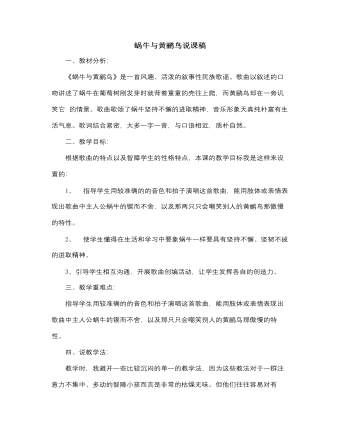
人音版小学音乐二年级上册蜗牛与黄鹂鸟说课稿
a.模仿老师一句一句地,有节奏地读歌词,注意老师手上的木鱼敲打的节奏。b.和老师一起把歌词读一遍,注意强调切分节奏的读法。c.学习歌曲:第一遍,老师一句一句地教学生唱,同时用电子琴弹出旋律。第二遍,老师一边一句一句地教唱,一边做出舞蹈动作,学生在下面模仿。d.学生听老师的电子琴伴奏,齐唱歌曲。2.歌曲演唱:演唱a.“有请我们班的小歌星子喻同学为我们演唱好不好?”b.“我们来组个乐团,怎么样?” c. “那我们的乐团起什么名字好呢?”“叽叽喳喳合唱团。”d. “现在老师宣布,我们的叽叽喳喳合唱团正式开演!”小结:“今天老师很高兴和同学们一起学习《蜗牛与黄鹂鸟》这首歌曲,老师看到了同学们的精彩表演,心里非常感动。在这里,老师希望同学们今后要像蜗牛一样,在学习上或者是生活上,不管遇到什么困难都勇敢面对,克服困难,坚持到底!同学们加油!
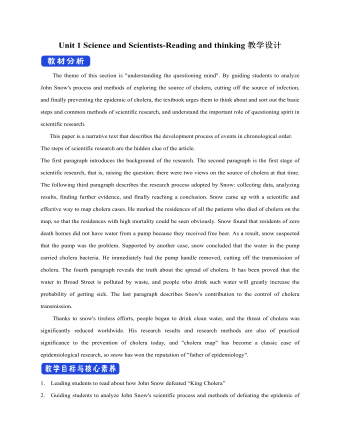
新人教版高中英语选修2Unit 1 Science and Scientists-Reading and thinking教学设计
Step 5: After learning the text, discuss with your peers about the following questions:1.John Snow believed Idea 2 was right. How did he finally prove it?2. Do you think John Snow would have solved this problem without the map?3. Cholera is a 19th century disease. What disease do you think is similar to cholera today?SARS and Covid-19 because they are both deadly and fatally infectious, have an unknown cause and need serious public health care to solve them urgently.keys:1. John Snow finally proved his idea because he found an outbreak that was clearly related to cholera, collected information and was able to tie cases outside the area to the polluted water.2. No. The map helped John Snow organize his ideas. He was able to identify those households that had had many deaths and check their water-drinking habits. He identified those houses that had had no deaths and surveyed their drinking habits. The evidence clearly pointed to the polluted water being the cause.3. SARS and Covid-19 because they are both deadly and fatally infectious, have an unknown cause and need serious public health care to solve them urgently.Step 6: Consolidate what you have learned by filling in the blanks:John Snow was a well-known _1___ in London in the _2__ century. He wanted to find the _3_____ of cholera in order to help people ___4_____ it. In 1854 when a cholera __5__ London, he began to gather information. He ___6__ on a map ___7___ all the dead people had lived and he found that many people who had ___8____ (drink) the dirty water from the __9____ died. So he decided that the polluted water ___10____ cholera. He suggested that the ___11__ of all water supplies should be _12______ and new methods of dealing with ____13___ water be found. Finally, “King Cholera” was __14_____.Keys: 1. doctor 2. 19th 3.cause 4.infected with 5.hit 6.marked 7.where 8.drunk 9.pump 10.carried 11.source 12.examined 13.polluted 14.defeatedHomework: Retell the text after class and preview its language points
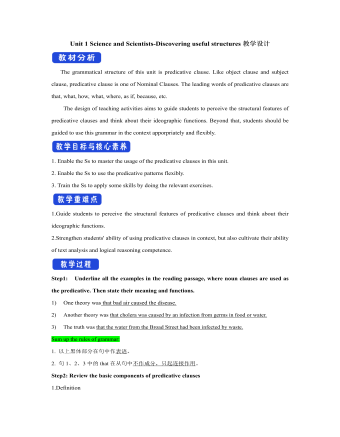
新人教版高中英语选修2Unit 1 Science and Scientists-Discovering useful structures教学设计
The grammatical structure of this unit is predicative clause. Like object clause and subject clause, predicative clause is one of Nominal Clauses. The leading words of predicative clauses are that, what, how, what, where, as if, because, etc.The design of teaching activities aims to guide students to perceive the structural features of predicative clauses and think about their ideographic functions. Beyond that, students should be guided to use this grammar in the context apporpriately and flexibly.1. Enable the Ss to master the usage of the predicative clauses in this unit.2. Enable the Ss to use the predicative patterns flexibly.3. Train the Ss to apply some skills by doing the relevant exercises.1.Guide students to perceive the structural features of predicative clauses and think about their ideographic functions.2.Strengthen students' ability of using predicative clauses in context, but also cultivate their ability of text analysis and logical reasoning competence.Step1: Underline all the examples in the reading passage, where noun clauses are used as the predicative. Then state their meaning and functions.1) One theory was that bad air caused the disease.2) Another theory was that cholera was caused by an infection from germs in food or water.3) The truth was that the water from the Broad Street had been infected by waste.Sum up the rules of grammar:1. 以上黑体部分在句中作表语。2. 句1、2、3中的that在从句中不作成分,只起连接作用。 Step2: Review the basic components of predicative clauses1.Definition
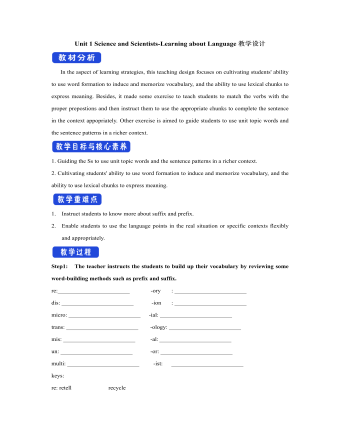
新人教版高中英语选修2Unit 1 Science and Scientists-Learning about Language教学设计
Step 7: complete the discourse according to the grammar rules.Cholera used to be one of the most 1.__________ (fear) diseases in the world. In the early 19th century, _2_________ an outbreak of cholera hit Europe, millions of people died. But neither its cause, 3__________ its cure was understood. A British doctor, John Snow, wanted to solve the problem and he knew that cholera would not be controlled _4_________ its cause was found. In general, there were two contradictory theories 5 __________ explained how cholera spread. The first suggested that bad air caused the disease. The second was that cholera was caused by an _6_________(infect) from germs in food or water. John Snow thought that the second theory was correct but he needed proof. So when another outbreak of cholera hit London in 1854, he began to investigate. Later, with all the evidence he _7_________ (gather), John Snow was able to announce that the pump water carried cholera germs. Therefore, he had the handle of the pump _8_________ (remove) so that it couldn't be used. Through his intervention,the disease was stopped in its tracks. What is more, John Snow found that some companies sold water from the River Thames that __9__________________ (pollute) by raw waste. The people who drank this water were much more likely _10_________ (get) cholera than those who drank pure or boiled water. Through John Snow's efforts, the _11_________ (threaten) of cholera around the world saw a substantial increase. Keys: 1.feared 2.when 3. nor 4.unless 5.that/which 6.infection 7.had gathered 8.removed 9.was polluted 10.to get 11. threat
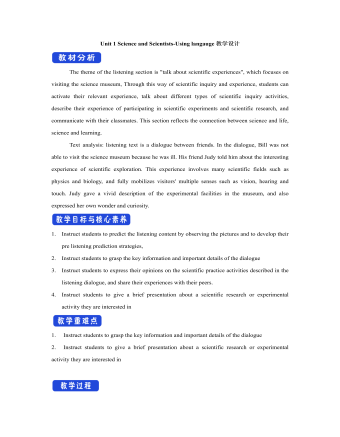
新人教版高中英语选修2Unit 1 Science and Scientists-Using langauge教学设计
This happens because the dish soap molecules have a strong negative charge, and the milk molecules have a strong positive charge. Like magnets, these molecules are attracted to each other, and so they appear to move around on the plate, taking the food coloring with them, making it look like the colors are quickly moving to escape from the soap.Listening text:? Judy: Oh, I'm so sorry that you were ill and couldn't come with us on our field trip. How are you feeling now? Better?? Bill: Much better, thanks. But how was it?? Judy: Wonderful! I especially liked an area of the museum called Light Games.it was really cool. They had a hall of mirrors where I could see myself reflected thousands of times!? Bill: A hall of mirrors can be a lot of fun. What else did they have?? Judy: Well, they had an experiment where we looked at a blue screen for a while, and then suddenly we could see tiny bright lights moving around on it. You'll never guess what those bright lights were!? Bill: Come on, tell me!? Judy: They were our own blood cells. For some reason, our eyes play tricks on us when we look at a blue screen, and we can see our own blood cells moving around like little lights! But there was another thing I liked better. I stood in front of a white light, and it cast different shadows of me in every color of the rainbow!? Bill: Oh, I wish I had been there. Tell me more!? Judy: Well, they had another area for sound. They had a giant piano keyboard that you could use your feet to play. But then, instead of playing the sounds of a piano, it played the voices of classical singers! Then they had a giant dish, and when you spoke into it, it reflected the sound back and made it louder. You could use it to speak in a whisper to someone 17 meters away.? Bill: It all sounds so cool. I wish I could have gone with you? Judy: I know, but we can go together this weekend. I'd love to go there again!? Bill: That sounds like a great idea!

北师大版初中七年级数学下册同底数幂的除法说课稿2篇
设计意图:知识的掌握需要由浅到深,由易到难.我所设计的三个例题难度依次上升,根据由简到难的原则,先让学生学会熟悉选用公式,再进一步到公式的变形应用,巩固知识.特别是第三题特别强调了运用法则的前提:必需要底数相同.为加深学生对法则的理解记忆,形成“学以致用”的思想.同时为了调动学生思考,接下来让学生进入反馈练习阶段,进一步巩固记忆.4、知识反馈,提高反思练习1(1)口答设计意图:根据夸美纽斯的教学巩固性原则,为了培养学生独立解决问题的能力,在例题讲解后,通过让个别同学上黑板演演,其余同学在草稿本上完成练习的方式来掌握学生的学习情况,从而对讲解内容作适当的补充提醒.同时,在活动中引起学生的好奇心和强烈的求知欲,在获得经验和策略的同时,获得良好的情感体验.
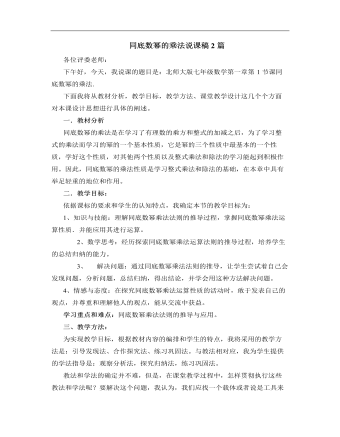
北师大版初中七年级数学下册同底数幂的乘法说课稿2篇
4、巩固新知,拓展新知(羊羊竞技场)本环节在学生对性质基本熟悉后安排了四组训练题,为避免学生应用性质的粗糙感,以小羊展开竞技表演为背景,让学生在轻松愉快的氛围中层层递进,不断深入,达到强化性质,拓展性质的目的。提高学生的辨别力;进一步增强学生运用性质解决问题的能力;训练学生的逆向思维能力,增强学生应变能力和解题灵活性.5、提炼小结完善结构(羊羊总结会)“通过本节课的学习,你在知识上有哪些收获,你学到了哪些方法?”引导学生自主总结。设计意图:使学生对本节课所学知识的结构有一个清晰的认识,能抓住重点进行课后复习。以及通过对学习过程的反思,掌握学习与研究的方法,学会学习,学会思考。6、课堂检测,发展潜能(大战灰太狼)
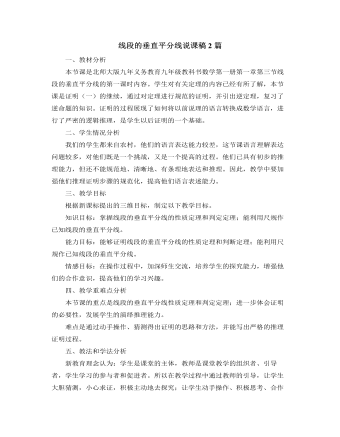
北师大版初中数学八年级下册线段的垂直平分线说课稿2篇
活动四:自主学习,尺规作图先阅读,再尝试作图,思考作图道理,小组讨论,“为什么作图过程中必须以大于1/2AB的长为半径画弧?”同桌演示尺规作图。最后折纸验证,使整个学习过程更加严谨。我将用下面这个课件给学生展示作图过程。再次回顾情境,让学生完成情境中的问题。(三)讲练结合,巩固新知第一个题目是直接运用性质解决问题,比较简单,面向全体学生。我还设计了第二个题目,想训练学生审题的能力。(四)课堂小结在学生们共同归纳总结本节课的过程中,让学生获得数学思考上的提高和感受成功的喜悦并进一步系统地完善本节课的知识。(五)当堂检测为了检测学生学习情况,我设计了当堂检测。第一个题目,让学生学会转化的思想来解决问题;第二个题目练习尺规作图。

北师大版初中七年级数学下册图形的全等说课稿2篇
一、教材分析1.教材的地位与作用本节课是在学生学习了三角形的基本概念后,引入图形的全等。这节课探究对象是生活中的常见全等图形,主要是探究全等图形的概念和特征,通过系列学习活动,引导学生体验数学与生活的密切联系,激发学生学习数学的兴趣,培养良好的学习品质。同时这节课的内容也是下一节学习全等三角以及三角形全等的判定的奠基石,它对知识的联系起到承上启下的作用。2.教学目标依据《课程标准》要求本阶段的学生应初步会运用数学的思维方式去观察、分析现实生活中出现的实际问题,体会数学与生活的密切联系,增进对数学的理解和学好数学的信心。因此我确立本节课的教学目标如下:知识技能目标:通过实例,使学生理解图形全等的概念,掌握全等图形的特征,能在不同的图形中识别出全等的图形过程与方法:通过观察,动手实验,培养学生动手操作能力、观察能力以及合作与交流的能力
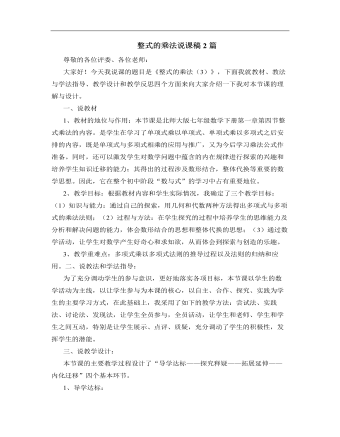
北师大版初中七年级数学下册整式的乘法说课稿2篇
练习3、先化简,再求值:2a(a-b)-b(2a-b)+2ab,其中a=2,b=-3.(通过例题和联系将所学知识升华,提升)练习4、动动脑。(让学生进一步感知生活中处处有数学)(四)、畅谈收获、拓展升华1、本节课你学到了什么?依据是什么?整式的乘法存在什么没有解决的问题?(同桌互讲,师生共同小结)2、布置作业:习题1.9知识技能1四、说课小结本堂课我主要采用引导探索法教学,倡导学生自主学习、尝试学习、探究学习、合作交流学习,鼓励学生用所学的知识解决身边的问题,注重教学效果的有效性。学生在合作学习中,可以活跃课堂气氛,消除心理压力,在愉快的环境中学习知识,有效地拓展学生思维,成功地培养学生的观察能力、思维能力、合作探究能力、交流能力和数学学习能力。但由于本人对新课标和新教材的理解不一定十分到位,所以在教材本身内在规律的把握上,会存在一定的偏差;另外,由于对学生的认知规律认识不够,所以教学活动的设计不一定十分有效。所有这些都有待教学实践的检验。

